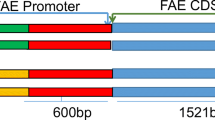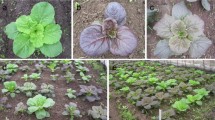Abstract
KCS (β-keto-acyl-CoA synthase) has been proposed as a candidate gene for explaining the erucic acid level in rapeseed. Degenerate PCR primers corresponding to the FAE1 gene have been designed. Two B. napus genes BN-FAE1.1 and BN-FAE1.2, corresponding to the parental species B. rapa and B. oleracea FAE1 genes, were amplified. Polymorphism was revealed for these two genes by acrylamide electrophoresis of the amplification products. These two genes could then be mapped and a co-segregation of these genes with the E1 and E2 loci controlling erucic acid content was found. Furthermore, mutations observed for one of these genes could explain part of the low erucic trait of the three LEAR types used in this study.
Similar content being viewed by others
Author information
Authors and Affiliations
Additional information
Received: 3 November 1997 / Accepted: 25 November 1997
Rights and permissions
About this article
Cite this article
Fourmann, M., Barret, P., Renard, M. et al. The two genes homologous to Arabidopsis FAE1 co-segregate with the two loci governing erucic acid content in Brassica napus. Theor Appl Genet 96, 852–858 (1998). https://doi.org/10.1007/s001220050812
Issue Date:
DOI: https://doi.org/10.1007/s001220050812




